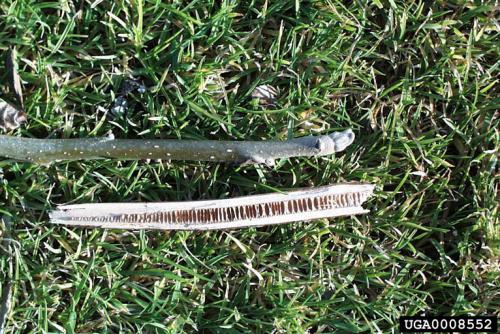Wintertime identification of black walnut
No leaves? No problem. Other characteristics can help to identify the species.

Even though spring isn’t quite around the corner, the weather in many parts of southern Michigan is decent enough to take some nice walks outside. This would also be a great time to begin thinking about adopting a sentinel tree for Michigan State University Extension’s Eyes on the Forest program (see** below for more information on this program).
To the untrained eye, identifying certain tree species without using the leaves can be daunting. If you’re interested in finding a black walnut tree, however, there are several distinguishing features that can help with identification. Different parts of the tree—including the bark, twigs, leaf buds, and fruit—can all be used to help with identification.
One key factor is where black walnut trees typically grow (geographically), otherwise described as their natural range. In Michigan, this species is rarely found north of a line stretching across the Lower Peninsula from around Ludington to Clare to Saginaw. This means that if you are walking through the woods near the tip of the mitten, the tree you are looking at is probably not a black walnut.
If the tree in question has twigs that are within reach, or can at least be easily seen, there are many possible features to look for:
- Twig structure: Thick, stout, and rigid twigs
- Terminal bud: The leaf bud located at the very tip of each twig. It should be short, stubby, slightly fuzzy, and grey in color.
- Side buds: The leaf buds found along the twig itself are small, and located within a “notch” of the scar left from the previous year’s leaf.
- Twig pith: If you can clip a sample of a twig, cut it longitudinally along its center. The inside of the twig will look light and spongy. Black walnuts will have pith arranged in horizontal layers, with larger spaces between the layers.

The center of walnut twigs reveals chambered pith.
Photo credit: Paul Wray, Iowa State University, Bugwood.org
If the tree is too tall to reach or easily see details of the twigs, the bark is also relatively characteristic. It is rather dark, with deeply furrowed ridges. These ridges often interlace, giving it an overall diamond-shaped pattern. When the surface of a ridge is cut away, it reveals a deep, chocolate brown. It’s also possible to look around the ground under the tree for other clues. Telltale shells of walnuts may persist long after a hungry squirrel has eaten its contents.
Whether a black walnut tree is found in forested settings or along roadsides, this species can grow to stately heights, and is an extremely valuable for both its wildlife and wood values. If you happen to choose one as a sentinel tree and register it on the MISIN website, keep an eye on it as it leafs out in the spring and grows through the summer. Look out for any leaf clusters that turn yellow in a short period of time, or large branches that seem to die without any obvious signs of physical injury. These could be clues that thousand cankers disease has infected it. In that case, reporting the sighting via MISIN or MDARD Customer Service Center at 800-292-3939 is an important next step.
**The Eyes on the Forest program gives citizens an opportunity to help keep new exotic pests and diseases from attacking the forest. It asks volunteers to adopt a ‘sentinel tree’ to periodically measure and monitor its condition. Once a sentinel tree is selected, volunteers can register it on the Midwest Invasive Species Information Network (MISIN) website. Currently there are three main threats the program is focusing on: Asian longhorned beetle, hemlock woolly adelgid, and thousand cankers disease of walnut. Although the program encourages volunteers to adopt a tree species that is vulnerable to these issues—black walnut, eastern hemlock, or a maple species—any tree species can be selected.



 Print
Print Email
Email


